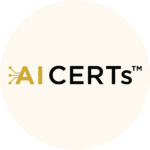
AI CERTS
5 months ago
AI Is Fueling a U.S. Economic Surge: The Future Is Now
According to recent reports, AI is fueling U.S. growth by enabling companies to automate processes, optimize logistics, and scale operations faster than ever before. This surge is now being reflected in GDP projections and labor market shifts.

The Numbers Behind the Surge
A recent Goldman Sachs report projected that generative AI alone could boost global GDP by nearly 7% over the next decade. The U.S. stands to be the biggest beneficiary, thanks to its AI-first companies and infrastructure. The same study found:
- AI could increase productivity growth by 1.5% annually over a 10-year period.
- 300 million full-time jobs globally could be impacted, with many transitioning into AI-assisted roles.
- Investment in AI-related technologies in the U.S. has soared beyond $250 billion in 2024 alone.
These indicators point to more than a technological trend—they signal a structural shift in the economy.
In summary, the financial backbone of the U.S. is being reinforced by its rapid AI adoption.
In the next section, we’ll explore how specific industries are being transformed.
AI's Economic Impact Across Key Sectors
1. Finance and Banking
AI is driving better fraud detection, real-time risk modeling, and customer service automation. JPMorgan, for example, has already rolled out AI-based investment advisors to clients.
2. Manufacturing
Predictive maintenance, robotic process automation (RPA), and smart inventory control have allowed factories to increase efficiency by over 20%.
3. Healthcare
AI-powered diagnostics and clinical decision support tools are reducing diagnosis time and improving patient outcomes. The U.S. healthcare sector saw over $8 billion in AI investment in 2024.
4. Retail and eCommerce
AI personalization tools are increasing customer retention and boosting average order values. Amazon's new AI-driven logistics network now predicts and fulfills regional demands with unprecedented accuracy.
AI is not merely improving existing workflows—it’s reinventing them.
Next, we’ll examine how small businesses and the workforce are adapting.
Small Businesses and Workforce Adaptation
While large corporations are leading the AI charge, small and medium-sized businesses (SMBs) are also seeing massive gains. With the availability of AI-as-a-service platforms, even lean startups can:
- Analyze large datasets with no-code tools.
- Deploy AI-powered marketing campaigns.
- Use chatbots to scale customer support without extra headcount.
🔄 Shifting Workforce Dynamics
The U.S. labor force is also evolving in response to AI. Rather than eliminating jobs entirely, AI is reshaping roles:
- Routine tasks are being automated.
- New positions like AI trainers, prompt engineers, and data auditors are emerging.
- Reskilling programs are gaining momentum, with both private and public sectors pushing workforce transformation.
AI isn’t replacing people—it’s amplifying them.
In the next section, we’ll explore the federal and policy response to AI-led growth.
Policy, Infrastructure, and Innovation Initiatives
Recognizing AI’s impact, the U.S. government is actively investing in:
- AI R&D through the National AI Initiative Act
- Public-private AI partnerships to bolster education and innovation
- Expansion of broadband infrastructure to support AI implementation in rural areas
The Biden administration recently proposed a $35 billion AI infrastructure budget, aimed at:
- Expanding access to AI tools for small businesses
- Building ethical frameworks and oversight mechanisms
- Increasing funding to public universities for AI research
These actions reflect a commitment to inclusive and sustained AI-powered growth.
Let’s now look at what the future holds.
Looking Ahead: What the Next Decade Could Bring
If current trends continue, experts predict that:
- By 2030, AI could contribute up to $15.7 trillion to the global economy, with a large portion centered in the U.S.
- The AI talent gap may become the biggest challenge, not innovation itself.
- A new wave of AI-native companies may emerge, much like how the internet birthed giants like Google and Facebook.
As more companies adopt AI, a flywheel effect is in motion: increased productivity leads to more investment, which leads to further innovation.
In conclusion, the U.S. isn’t just witnessing an economic shift—it’s spearheading an AI-led revolution.
In the final section, we’ll offer ways to capitalize on this momentum.
🏆 Recommended Certifications to Lead the AI Wave
- AI Business – AI CERTs
Ideal for business leaders and executives looking to adopt AI strategically. - AI Project Manager – AI CERTs
Designed for professionals driving AI projects within organizations.
If this article helped you understand how AI is fueling U.S. growth, you’ll love diving deeper into these trends:



